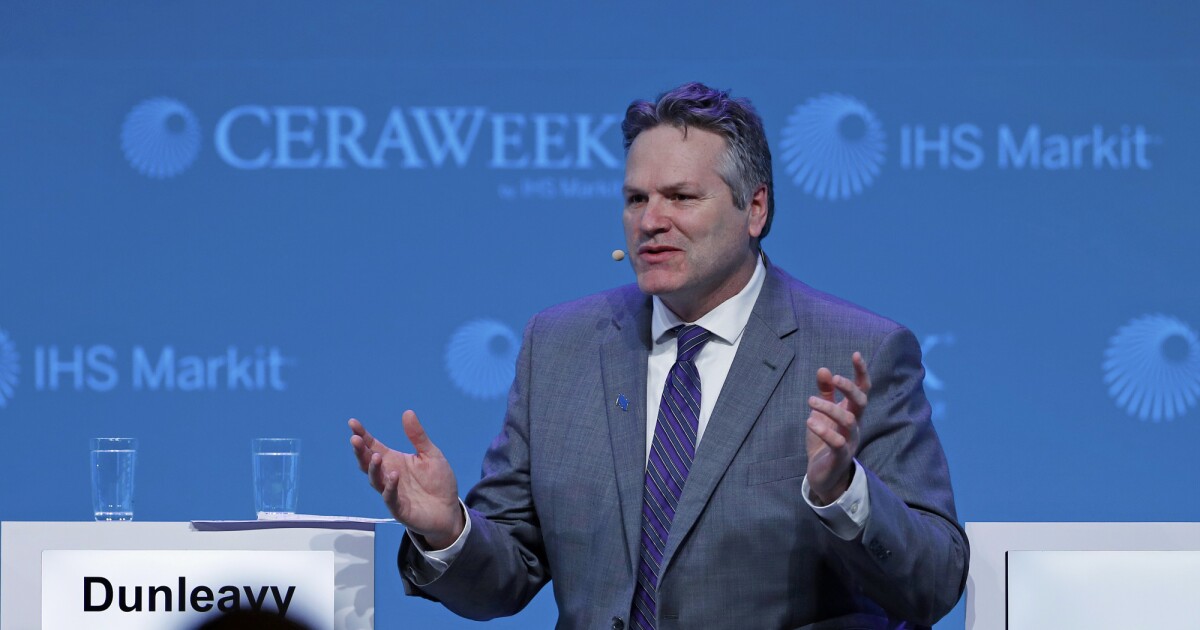Alaska governor wants state to play in carbon markets
6 min read
Alaska’s governor is seeking new revenue sources to smooth out the volatility in state revenues that comes from its dependence on oil.
Gov. Mike Dunleavy highlighted a proposed carbon management bill package during his State of the State speech on Monday that he says would capitalize on new markets in carbon reduction.
“With support for our carbon monetization bill, we’ll change the conversation about new revenue from the tired thinking of the past,” Dunleavy said.
The governor referred to his carbon package as the “cornerstone of a long-term fiscal solution” that would complement revenue from oil and gas and the Alaska Permanent Fund, a state-owned investment fund created in 1976 to smooth out the ups and downs from its dependence on oil.
The state’s residents annually receive a dividend from the fund of an amount agreed to by lawmakers when the budget passes. The state government, which doesn’t levy an income tax or sales tax, relies heavily on oil revenue and earnings from the Permanent Fund.
Alaska expects to have a balanced budget in fiscal 2023, but is projecting a $265.2 million deficit in 2024, according to a Friday presentation Neil Steininger, director of Alaska’s Office of Management and Budget, made to Commonwealth North, a non-partisan organization that seeks to educate Alaskans on public policy issues.
The fiscal year 2024 budget totals $4.8 billion in unrestricted general funds for a total preliminary budget of $7.3 billion.
Dunleavy’s carbon package would give the Alaska Department of Natural Resources the authority to promote carbon management and sequestration.
The proposal involves capturing man-made carbon dioxide and storing it underground for other uses.
“We’ll continue to lead in the production of oil, of natural gas, of conventional and critical minerals. At the same time, our potential will allow us to emerge as the global leader in new forms of low and no carbon energy,” Dunleavy said in his address.
Though Congress has provided support for research in the area since 2010, and most recently through the federal infrastructure bill, there remains a difference of opinion as to the value of the practice. Some policymakers see carbon capture and sequestration as an option to mitigate carbon dioxide emissions, but others are concerned it could encourage continued fossil fuel use and that carbon dioxide could leak from underground reservoirs, according to an October report from Congressional Research Services.
“U.S. facilities capturing and injecting Co2, and projects under development, operate in five industry sectors: chemical production, hydrogen production, fertilizer production, natural gas processing, and power generation,” according to the CSR report. “Most projects use the injected Co2 to increase oil production from aging oil fields, known as enhanced oil recovery, while some facilities capture and inject Co2 with the aim to sequester the Co2 in underground geologic formations.”
The Petra Nova project in Texas, starting operation in 2017, was the first and only U.S. fossil-fueled power plant generating electricity and capturing Co2 in large quantities (over 1 million metric tons per year) until carbon capture operations were suspended in 2020, according to the report.
Since fiscal year 2010, Congress has provided $9.2 billion in annual appropriations for its Fossil Energy and Carbon Management Research, Development, Demonstration, and Deployment program, of which $2.7 billion was directed to carbon capture-related budget line items, according to the Congressional Research Services report.
The Infrastructure Investment and Jobs Act provided $8.5 billion in supplemental funding for carbon capture for fiscal years 2022-2026, including funding for the construction of new carbon capture facilities, plus another $3.6 billion for direct air capture.
The second prong of Dunleavy’s proposal would be to set up a carbon offset program similar to California’s cap-and-trade program where companies can buy or sell offsets or credits to comply with regulations on greenhouse gas emissions or to meet voluntary emissions goals.
Alaska Native regional corporations like Sealaska, Chugach Alaska Corporation and Ahtna Inc. have been participating in carbon markets for years, by turning sustainably managed forests into carbon credits. Those credits have been bought and sold by companies outside of the state, particularly in California through the Golden State’s cap-and-trade program.
Dunleavy told the Alaska Beacon that, even though he doesn’t believe carbon emissions have anything to do with climate change, he’s willing to take advantage of the markets that exist for carbon credits and will exist if carbon sequestration becomes a reality at scale.
“Monetizing carbon has a very real potential of bringing revenue to the State of Alaska to the tune of millions, if not billions, of dollars,” he said in a news release.
“We’ll unlock our stranded North Slope gas to power Alaska, to supply our Asian allies, and to produce zero carbon energy in the form of hydrogen and ammonia,” Dunleavy said in his State of the State speech. “We’ll take advantage of Cook Inlet’s resources with nearly 20% of the world’s tidal energy and 50 gigatons of carbon storage potential for industrial and international customers. We’ll attract investment and generate new revenue through our forests, our coastlines and our oil and gas basins.”
Dunleavy proposed a capital budget that is down $460 million from fiscal year 2023. Due to lower than expected oil prices, the budget calls for a modest draw from the constitutional budget reserve of $245 million, and $20 million from the Statutory Budget Reserve. The combined balance for the SBR and CBR accounts is $2.1 billion, according to the governor’s budget proposal.
Steininger outlined the struggles the state faces with long-term fiscal planning because of its dependence on oil revenues during his presentation to Commonwealth North.
The state saw a hit to its coffers when oil prices dropped in 2020, but then received a windfall as oil prices spiked after Russian President Vladimir Putin invaded Ukraine in February 2022, with revenues jumping from $2 billion to $5 billion, Steininger said.
By the time the budget had passed in 2022, revenues had grown another $1 billion.
“Oil prices spiked to their highest level when Dunleavy signed the budget [on June 28, 2022], but then dropped significantly just two months later,” Steininger said. “It’s tough to do any long-range planning with this level of volatility.”
Dunleavy, however, said in his speech that he is optimistic “about the next four years — and the next 50 — because of everything we’ve achieved in the last four years to reach this moment in time, despite everything we’ve faced such as natural disasters, a $1.6 billion deficit, debts and credit downgrades, a record-breaking crime wave, negative $3 oil, a pandemic and inflation at a 40-year high.”
“In spite of it all, we’re still here, we’re still standing, and we’re moving forward,” the governor said.
The state “delivered the largest Permanent Fund dividend in history” of $3,200 last fall “at a time when Alaskans needed it most,” Dunleavy said. “Our credit outlook is improved, and our debts and liabilities are down.”
The state has experienced ups and downs with its revenue profile for decades.
When Fitch Ratings analysts revised the state’s outlook to stable from negative in April they said the surge in energy prices had bolstered the state’s financial resilience by enabling it to build up reserves, giving it a better cushion. Fitch also affirmed the state’s A-plus issuer default rating and general obligation bond rating.
Fitch was the most recent to assign an improved outlook to the state.
S&P Global Ratings revised its outlook on Alaska’s AA-minus rating to positive from stable on March 31, and Moody’s revised the outlook on its Aa3 rating to stable from negative in 2021.
The S&P revision “reflects our view that there is at least a one-in-three change we could raise our rating on Alaska’s GO debt over our two-year outlook period,” analysts wrote.
Moody’s affirmed on Monday the state’s Aa3 rating and stable outlook on $621.9 million of outstanding general obligation bonds, and assigned the Aa3 rating to $56 million in GO refunding bonds the state plans to price next week.
“Alaska’s Aa3 rating reflects the state’s ability to fund operations partly using earnings of the Alaska Permanent Fund,” Moody’s analysts wrote. “Credit challenges, such as a narrow economy, comparatively large net pension liability in relation to revenue and high economic and revenue exposure to the petroleum extraction industry are largely offset by the ability to systematically draw on permanent fund profits for operating needs and relatively low fixed costs.”
None of the ratings agencies have weighed in on Dunleavy’s carbon capture plan.
“Our history is always being written, including right now,” Dunleavy said in his State of the State address. “The question for all of us is what do we want history to be? Will be fighting over the PFD in 50 years? Or, will we have settled this issue long before by respecting the voices of Alaskans?”







